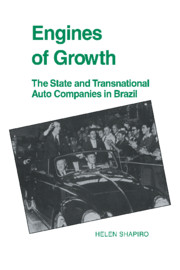Book contents
- Frontmatter
- Contents
- Tables and Figures
- Acknowledgments
- 1 Approaches to State Intervention
- 2 Why Auto?
- 3 The Determinants of Firm Entry
- 4 Rent Redistribution and Linkage Effects
- 5 The Automotive Parts Sector
- 6 Conclusion
- Appendix A Data Exhibits on the Brazilian Auto Industry
- Appendix B José Almeida's Calculation of Subsidies Provided to the Brazilian Automotive Industry
- Index
4 - Rent Redistribution and Linkage Effects
Published online by Cambridge University Press: 11 September 2009
- Frontmatter
- Contents
- Tables and Figures
- Acknowledgments
- 1 Approaches to State Intervention
- 2 Why Auto?
- 3 The Determinants of Firm Entry
- 4 Rent Redistribution and Linkage Effects
- 5 The Automotive Parts Sector
- 6 Conclusion
- Appendix A Data Exhibits on the Brazilian Auto Industry
- Appendix B José Almeida's Calculation of Subsidies Provided to the Brazilian Automotive Industry
- Index
Summary
Due to the variety of objectives the auto industry was supposed to achieve, the criteria for evaluating the outcome are not self-evident. The previous chapter documented how government policies successfully met the objectives of attracting foreign capital into Brazil and installing a domestic automotive industry. This chapter further develops the argument that the industrial strategy was a success by assessing several performance indicators. The criteria considered here include the distribution of rents between the transnational auto firms and the Brazilian government, production costs and prices, and linkage effects.
The chapter first considers the special subsidies provided to the auto firms and then studies tax rates, prices, and profit margins. A comparison of subsidies and tax revenues shows that, even in the industry's first five years, the amount of taxes paid by the vehicle assemblers on federal, state, and local levels more than compensated for the indirect subsidies they received. By the mid-1960s, production costs and prices were declining, as were profit margins. Therefore, the indirect incentives provided to the industry did not represent a pure subsidy because the state ultimately recovered all of its forfeited revenues. Also, as production levels increased and firms consolidated, the industry became more efficient and production costs fell.
The chapter then looks at the sector's linkage effects. Brazilian planners explicitly used the U.S. economy as the model they hoped to duplicate. They observed that the job of one in eight U.S. workers was connected to auto production, and they expected the industry similarly to transform the Brazilian economy.
- Type
- Chapter
- Information
- Engines of GrowthThe State and Transnational Auto Companies in Brazil, pp. 134 - 190Publisher: Cambridge University PressPrint publication year: 1994



